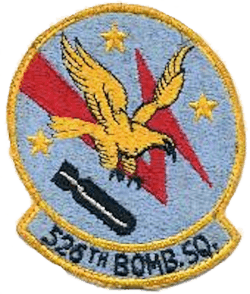526th Bombardment Squadron
| 526th Bombardment Squadron | |
|---|---|
|
Emblem of the 526th Bombardment Squadron | |
| Country | United States |
| Branch | United States Air Force |
| Type | Bombardment |

The 526th Bombardment Squadron is an inactive United States Air Force unit. It was last assigned to the 4042d Strategic Wing. It was last stationed at K. I. Sawyer Air Force Base, Michigan, and was inactivated on 1 February 1963.
History
Established in late 1942 as a B-17 Flying Fortress heavy bomb squadron; trained under Second Air Force. Deployed to the European Theater of Operations (ETO) in May 1943, being assigned to VIII Bomber Command in England. Engaged in long range strategic bombing attacks on enemy targets over occupied Europe and Nazi Germany, such as industries, oil refineries, storage plants, submarine pens, airfields and communications centers in Germany, France, the Netherlands, Belgium, Norway and Poland. During the Battle of Northern France, the squadron bombed enemy positions to assist ground troops at St Lo during the breakthrough, 24–25 July 1944, attacked German communications and fortifications during the Battle of the Bulge, December 1944 - January 1945, and bombed bridges and viaducts in France and Germany to aid the Allied assault across the Rhine, and the Western Allied invasion of Germany, February–April 1945.
After the German Capitulation, was reassigned to Air Transport Command in June 1945 as part of Operation Green. Used B-17s as transports, flying demobilized personnel to from airfields in France, Germany and Italy to ATC sites in Morocco and Azores. Aircraft turrets were removed and re-skinned, the bomb racks removed, flooring and seating installed to accommodate 30 passengers. The flight crew was reduced to pilot, co-pilot, navigator, flight engineer and radio operator. In addition the engineer and radio operator would act as stewards, to assist and calm the many first time fliers. Inactivated in July 1945.
Was reactivated in 1955 as a Strategic Air Command B-47 Stratojet squadron at Homestead AFB, Florida. Trained in air refueling and strategic bombardment operations with the B-47. in October 1960, the squadron began transferring its B-47s to other SAC wings and became non-operational.
In 1961 was reassigned to SAC provisional 4042d Strategic Wing, being re-equipped with B-52H Stratofortress intercontinental heavy bombers. Was reassigned to K. I. Sawyer AFB, Michigan by SAC to disperse its heavy bomber force. Conducted worldwide strategic bombardment training missions and providing nuclear deterrent. Was inactivated in 1963 when SAC inactivated its provisional Strategic Wings, redesignating them permanent Air Force Wings. Squadron was inactivated with aircraft/personnel/equipment being redesignated 644th Bombardment Squadron in an in-place, name-only transfer.
Lineage
- Constituted 526th Bombardment Squadron (Heavy) on 28 Oct 1942
- Activated on 3 Nov 1942
- Inactivated on 25 Jul 1945
- Redesignated 526th Bombardment Squadron (Medium) on 12 Jul 1955
- Activated on 1 Nov 1955
- Redesignated 526th Bombardment Squadron (Heavy) on 9 Jan 1961
- Discontinued and inactivated on 1 Feb 1963; aircraft/personnel/equipment redesignated 644th Bombardment Squadron.
Assignments
- 379th Bombardment Group, 3 Nov 1942-25 Jul 1945
- 379th Bombardment Wing, 1 Nov 1955
- 19th Bombardment Wing, 9 Jan 1961
- 4042d Strategic Wing, 1 Jun 1961-1 Feb 1963
Stations
- Geiger Field, Washington, 3 Nov 1942
- Wendover Field, Utah, 2 Dec 1942
- Sioux City Army Air Base, Iowa, 2 Feb-9 Apr 1943
- RAF Kimbolton (AAF-117), England, 20 May 1943-c. 16 Jun 1945
- Casablanca Airport, French Morocco, 17 Jun-25 Jul 1945
- Homestead AFB, Florida, 1 Nov 1955
- K. I. Sawyer AFB, Michigan, 1 Jun 1961-1 Feb 1963
Aircraft
- B-17 Flying Fortress, 1942-1945
- B-47 Stratojet, 1956-1961
- B-52 Stratofortress, 1961-1963.
See also
References
![]() This article incorporates public domain material from the Air Force Historical Research Agency website http://www.afhra.af.mil/.
This article incorporates public domain material from the Air Force Historical Research Agency website http://www.afhra.af.mil/.
- Maurer, Maurer, ed. (1982) [1969]. Combat Squadrons of the Air Force, World War II (PDF) (reprint ed.). Washington, DC: Office of Air Force History. ISBN 0-405-12194-6. LCCN 70605402. OCLC 72556.


